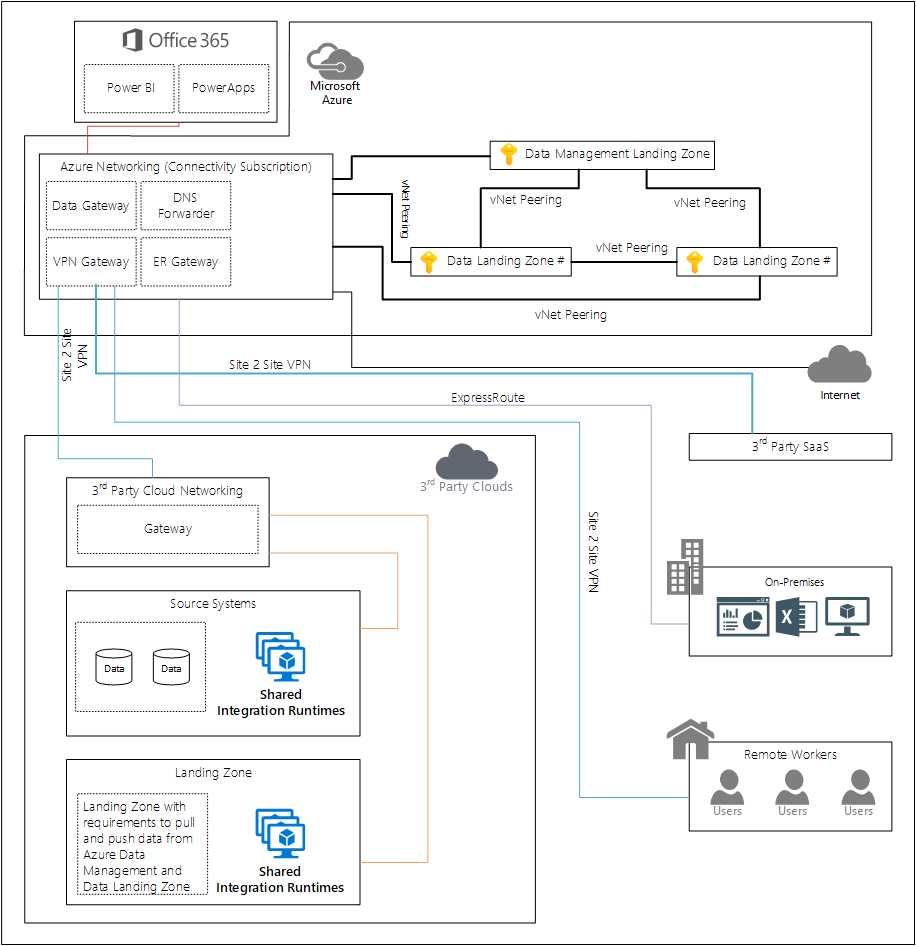Networking overview
This article has design considerations and guidelines for networking and connectivity to or from data management landing zones and data landing zones. It builds on information in the Azure landing zone design area for network topology and connectivity article.
Since data management and data landing zones are important, you should also include the guidance for the Azure landing zone design areas in your design.
This section outlines gives a high level overview of the networking pattern with further links to deploying in both single and multiple azure regions.
Cloud-scale analytics promises the possibility to easily share and access datasets across multiple data domains and data landing Zones without critical bandwidth or latency limitations and without creating multiple copies of the same dataset. To deliver on that promise, different network designs have to be considered, evaluated, and tested to make sure that these are compatible with the existing hub and spoke and vWAN deployments of corporations.
 Figure 1: Networking overview for cloud-scale analytics.
Figure 1: Networking overview for cloud-scale analytics.
Important
This article and other articles in the networking section outline cross-business units that share data. However, this might not be your initial strategy and that you need to start at a base level first.
Design your networking so that you can eventually implement our recommended setup between data landing zones. Ensure you have the data management landing zones directly connected to the landing zones for governance.
Data management landing zone networking
You can connect virtual networks to each other with virtual network peering. These virtual networks can be in the same or different regions, and are also known as global VNet peering. After peering the virtual networks, resources in both virtual networks communicate with each other. This communication has the same latency and bandwidth as if the resources were in the same virtual network.
The data management landing zone connects to the Azure networking management subscription using virtual network peering. The virtual network peering then connects to on-premises resources using ExpressRoute circuits and third-party clouds.
Data management landing zone services that support Azure Private Link are injected into the data management landing zone virtual network. For example, Azure Purview supports Private Link.
Data management landing zone to data landing zone
For every new data landing zone, you should create a virtual network peering from the data management landing zone to the data landing zone.
Important
A data management landing zone connects to an data landing zone using virtual network peering.
Data landing zones to data landing zones
There are options on how to make this connectivity and depending on if you have a single or multiple region deployment it is recommended that you consider the guidance in:
Data management landing zone to third-party clouds
To set up connectivity between a data management landing zone and a third-party cloud, use a Site-to-Site VPN gateway connection. This VPN can connect your on-premises or third-party cloud landing zone to an Azure virtual network. This connection is created over an IPsec or internet key exchange v1 or v2 (IKEv1 or IKEv2) VPN tunnel.
Site-to-Site VPNs can provide better continuity for your workloads in a hybrid cloud setup with Azure.
Important
For connections to a third-party cloud, we recommend implementing a Site-to-Site VPN between your Azure connectivity subscription and the third-party cloud connectivity subscription.
Private endpoints
Cloud-scale analytics uses Private Link, where available, for shared platform as a service (PaaS) functionality. Private Link is available for several services and is in public preview for more services. Private Link addresses data exfiltration concerns related to service endpoints.
For the current list of supported products, see Private Link resources.
If you are planning on implementing cross tenant private endpoints, it's recommend that you review Limit cross-tenant private endpoint connections in Azure.
Caution
By design, cloud-scale analytics networking uses private endpoints where available to connect to PaaS services.
Implement Azure DNS resolver for private endpoints
Handle DNS resolution for private endpoints through central Azure Private DNS zones. Required DNS records for private endpoints can be automatically created using Azure Policy to allow access through fully qualified domain names (FQDNs). The lifecycle of the DNS records follows the lifecycle of the private endpoints. It's automatically removed when the private endpoint is deleted.
Next steps
Feedback
Coming soon: Throughout 2024 we will be phasing out GitHub Issues as the feedback mechanism for content and replacing it with a new feedback system. For more information see: https://aka.ms/ContentUserFeedback.
Submit and view feedback for